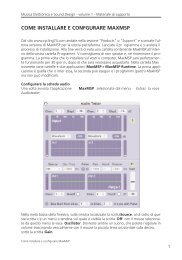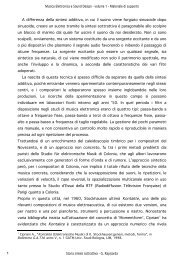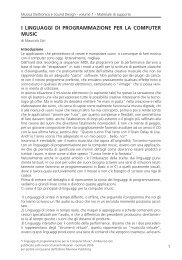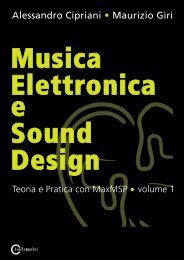programming with max/msp - Virtual Sound
programming with max/msp - Virtual Sound
programming with max/msp - Virtual Sound
You also want an ePaper? Increase the reach of your titles
YUMPU automatically turns print PDFs into web optimized ePapers that Google loves.
1.2<br />
14<br />
Theory<br />
If the amplitude of a wave being output by an algorithm exceeds the <strong>max</strong>imum<br />
permitted by the audio interface (a wave, for example, that ranges between<br />
1.2 and -1.2, being output by an interface that cannot accurately play values<br />
greater than 1), all of the values exceeding 1 or falling below -1 will be limited<br />
respectively to the <strong>max</strong>imum and the minimum value: offending values will be<br />
“clipped” to the values 1 or -1. Clipped waves are deformed, and because of<br />
this, their sound is distorted 11 (see fig. 1.13).<br />
amplitude<br />
�<br />
���<br />
�<br />
����<br />
��<br />
Fig.1.13 A “clipped” waveform<br />
� � � � � ��<br />
time in msec<br />
Paragraph 1.2 - Frequency, amplitude, and waveform<br />
In most software, besides using “raw” numbers to represent amplitude, it is<br />
also possible to indicate levels by using dB SPL: the symbol dB indicates that<br />
the level is to measured in deciBels, and the acronym SPL stands for <strong>Sound</strong><br />
Pressure Level. Whereas raw amplitude measurements represent the difference<br />
between a sound pressure measurement and some normal pressure, SPL is<br />
instead defined as the relationship of a sound pressure at a given moment to a<br />
reference pressure (which is typically 0 dB in digital audio). 0 dB SPL represents<br />
the highest level of accurately reproducible pressure (corresponding to the <strong>max</strong>imum<br />
amplitude), and lower levels are indicated by negative values.<br />
Using this scale, the raw amplitude 1, as used in the preceding examples,<br />
would correspond to 0 dB SPL, while a magnitude of 0.5 would correspond<br />
to approximately -6 dB, and an amplitude of 0.25 would fall still lower on the<br />
scale at approximately -12 dB. It follows that a reduction of 6 dB corresponds<br />
to a halving of the amplitude, whatever the level may be. This kind of relative<br />
measurement is very useful because you can use it while working <strong>with</strong> sounds<br />
of unknown loudness.<br />
11 As we will see in Section 5.1, harmonic distortion is the modification of a signal due to the<br />
alteration of its waveform, which results in the introduction of spectral components that are not<br />
found in the original signal.<br />
from “Electronic Music and <strong>Sound</strong> Design” Vol. 1 by Alessandro Cipriani and Maurizio Giri<br />
© ConTempoNet 2010 - All rights reserved







